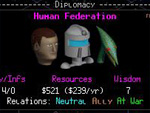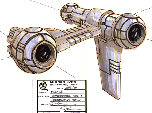|
How important are graphics in a 4X game?
|
Ewanchyna: I think graphics are important to all games,
given how visually oriented humans are. With that said, it
then just becomes a question of what you're trying to represent
with the graphics. I think that a 4X game needs the graphics
to serve the interface. It's the presentation of information
that's important in a 4X game. If the graphics don't aid the
player, then they're of little use but as eye-candy. Of course,
the vast majority of people prefer eye-candy to gameplay and
action to thinking, so one has to hope the 4X audience is
more sophisticated than the casual game player. Basically,
the more you can maximize eye-candy, gameplay, action and
thinking, the wider the appeal for the game.
|
Emrich: Pretty significant if you want to evoke what
we’re after, which is a 5X game, that 5th X being “eXperience.”
If we’re really going to pull you into the whole breadth
and scope of this epic, the graphics cannot let us down. Graphics
are the road a player travels on his way toward a suspension
of disbelief.
Hoseley: It depends on whether or not we want the
4X (or 5X, to use Alan’s parlance) genre to grow and
be seen as a viable option by publishers. My two cents on
it is that one of the major reasons that the 4X genre doesn’t
attract more gamers is the art doesn’t allow for you
to lose yourself in the game. The tables, information, and
stats can allow for the grognard to get lost in his own head,
but immersion in the ‘world’ of the game itself
is pretty difficult at best. There are more intuitive ways
to present this kind of game. There are more visually pleasing
ways to do it, and our goal is to really have the players
lose themselves in the world of MOO. We want the players to
lose track of time playing it. Graphics and an intuitive interface
go a long way in helping to facilitate that.
Fisher: Graphics are key, but perhaps not in the way
that would be obvious. Rantz [Hoseley] has carefully crafted
a very clean, elegant user interface that's also strikingly
attractive. The ship models and aliens are several steps up
from what has been seen before. And the cinematics are going
to be wonderful. But this isn't a game about eye candy and
flash. It's a more understated game, in keeping with the genre.
After all, we don't want all sorts of blinking, flashing,
pulsing color bursts on the screen constantly. This isn't
MTV. Nor will we be showing you the combat from over the shoulder
of the individual warrior. We're bringing the scope of the
game up a level, so you're not looking at individuals very
often (diplomacy being the major exception), but rather spending
your time watching entire fleets or examining complete solar
systems. There's a lot of craftsmanship in the art for the
game, but we're not going to come out and hit you over the
head with it.
|
Your own project excepted, what is currently your favorite 4x
space game?
|
Ewanchyna: Do you really think that I'd be interested
in playing another 4X space game after developing and endlessly
playing Starships Unlimited for the last 3 1/2 years? The
truth is, it's been months since I last got into any computer
game. I find myself sampling games from the internet, just
like everyone else.
|
Emrich: Well, it should surprise no one to learn that
it’s Master of Orion II, but also Twilight Imperium 2
(that boardgame I mentioned earlier). Awesome games, both.
Hoseley: There are nice bits that I like from various
games. I like Alpha Centauri because it’s Sid Meier and
it’s Civ in space. STARS! Supernova has some really nice
ship design, and there are various games that have nice little
bits in them, but one that’s my favorite? That’s
hard to say.
|
Some people criticized Sid Meier's Alpha Centauri for having
funky sci-fi technologies like Super String Theory, Ethical Calculus,
and Applied Relativity. Is it possible to create your own sci-fi
universe and avoid being alien to the player or do you have to use
the conventions established in popular science fiction?
|
Ewanchyna: That depends if you want to be successful
or not and what your definition of success is. You can have
a very original game that only a few people will love, thinking
it's the greatest game ever created. On the other hand you
can have a more conventional sci-fi game with broader appeal.
If you deal with issues that are too academic or impractical,
then you're going to alienate most people. Sci-fi is too small
a genre to risk that.
I think a better approach is to base the game on the standard
conventions of popular sci-fi, but expand it slightly in the
direction you want to go. In this way people will connect
with you game right away. If successful, you can grow a franchise
by continuing to move the game in the direction you want.
I think the rules of creating a good sci-fi game are the
same as creating a good sci-fi story. If you were to take
the elements of your game and try to write stories from it,
then you could get a sense of how good the game is based on
the stories you could write from it. In the case of SMAC's
heady technologies, you'd have to write a story with a pretty
clever hook, as most people would be too disconnected from
the technology to see it's relevance. This in turn may lead
you to change the focus of the game.
|
Emrich: You could go either way. For MOO3, we’re
sticking with popular conventions (and adding a few twists
of our own to extend that convention just a bit).
Fisher: You need to stay rooted in the familiar. One
of the most appealing things about the Star Wars or Star Trek
universes is that they're more like our own than different.
Sure, the wallpaper is new, but people still live in houses,
pilot vehicles, and have relationships that mirror the variety
in our own society. In the same way, our technologies begin
with that which we know about our own universe and then extrapolate
in as "realistic" a manner as possible into the
distant future. If we created our own universe, it would feel
far more alien. And we'd probably have one heck of a time
play-balancing it, since we'd have nothing real to compare
with.
|
Back to Features
Next
page
|

